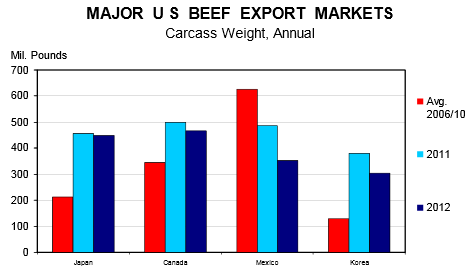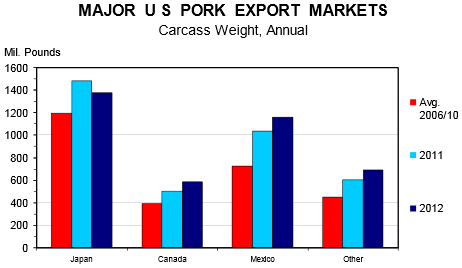



CME: Canada, Mexico Critical for US Beef, Pork Shipments
US - The reaction of Canada’s government to USDA’s proposed "fix" for mandatory country-of-origin labeling was predictable and swift, write Steve Meyer and Len Steiner.Canadian Agriculture Minister Gerry Ritz stated, among other things, that Canada was "extremely disappointed with the proposed regulatory changes" and that Canada would consider all options, including retaliatory measures, should the US not meet the 23 May 2013 deadline set by the World Trade Organization for US compliance. Canada does not believe the rule changes proposed on Friday accomplish that and pointed out that it believes the changes, in fact, increase the discrimination against Canadian cattle and hogs.
Regardless of your opinion of the value or need for origin labeling, the goal here must be to avoid retaliatory tariffs on US products. Should the US actions be deemed insufficient, Canada and Mexico will have great latitude in picking the retaliation targets and US beef and pork are logical choices since those products a) are directly involved in the dispute, b) represent large values for US producers and c) are represented by two pretty effective lobbies in Washington. There would be little point in picking on someone who cannot be of help in the policy battles so we think Canada will choose their targets carefully.
And plenty is at stake here! As can be seen below, Canada was the largest market for US beef exports last year, taking 467.2 million pounds of carcass weight product. That total represented 19 per cent of all US beef exports and just edged out the 449.6 million pounds (18.3 per cent of the total) sent to Japan. Mexico was our third largest beef market at 351.8 million pounds, carcass weight, (14.3 per cent of the total) but that number is less than half of the total beef we sent southward in 2008 and was down 28 per cent from 2011 largely due to higher US beef prices. Canada was also our largest beef export market in terms of value last year, taking product worth $1.148 billion which accounted for 21.2 per cent of the total value of US beef exports. Mexico continues to be our largest customer for beef variety meats, purchasing 80,477 metric tons worth $209 million in 2012. Mexico’s beef variety meat purchase shares are 25 per cent for quantity and 29.8 per cent for value.

Japan is still the largest market for US pork muscle cut exports but Mexico is now a close second and Canada ranks fourth, just behind China/Hong Kong. Mexico took 1.163 billion pounds of carcass-weight pork in 2012. That is 21.6 per cent of total exports, just 4 per cent short of Japan’s leading 25.6 per cent share. Canada purchased 587.1 million pounds of carcass weight pork last year, 10.9 per cent of the total. Mexican pork muscle cut exports accounted for just over 16 per cent of the total value of US pork exports while shipments to Canada accounted for 15.2 per cent of total value. Mexico is the largest destination for US pork variety meats, taking 36 per cent of our total exports and accounting for 29 per cent of the total value of variety meats.

Any way you cut it, these two markets are critical for US beef and pork shipments and, in spite of (or perhaps because of) USDA’s proposed rule change, are in grave danger. Some readers may wonder why pork to Mexico is an issue since virtually no pork is imported from Mexico and thus harmed by the MCOOL programs. The answer lies in the leeway that injured countries have in designating retaliation targets and the past effectiveness of Mexico’s pork lobby in getting US pork included on retaliation lists. The best example of that was the dispute over Mexican trucks not being allowed to operate in the US when US pork was included in the retaliation list in spite of US pork producers support of Mexico’s position in the dispute. It didn’t matter that we were helping them and it will not likely matter this time that very little of their product is injured.
An important final point is this: Reconciling this situation is going to take awhile and, even if the US rules are found insufficient by the WTO, it will be at least several months before any tariffs are imposed. In fact, it may well be 2014 before US exporters must deal with them. The specter of tariffs may dampen some business relationships in the short run but actual price increases — and resulting quantity decreases — for US product in these markets are still down the road a ways. Much can happen in the meantime. Let’s hope it does!







